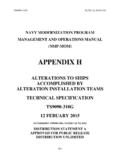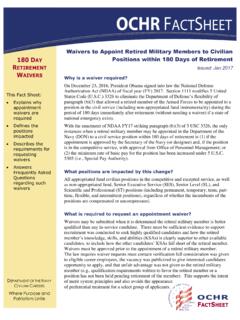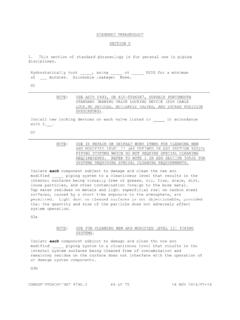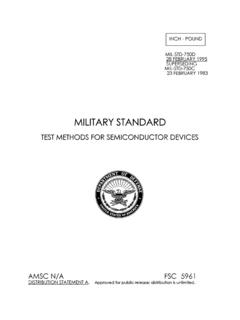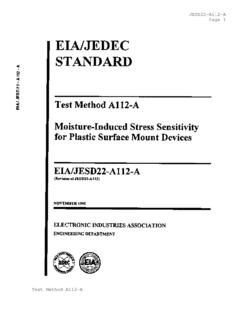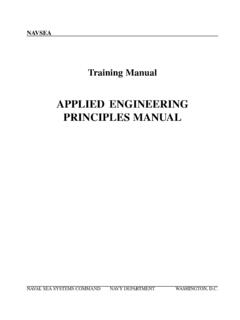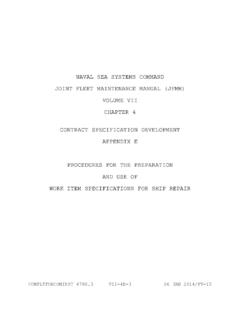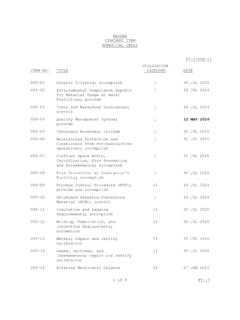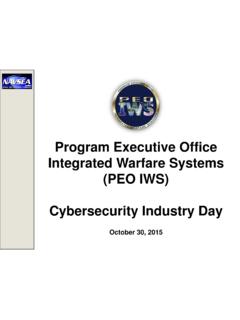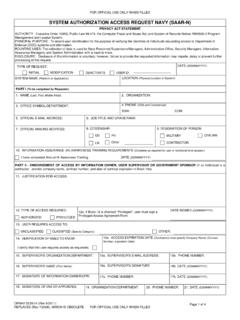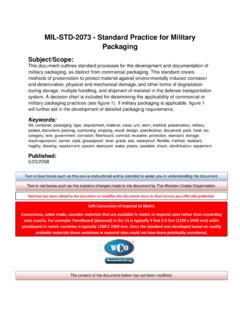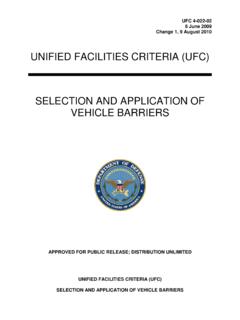Transcription of DEPARTMENT OF DEFENSE HANDBOOK - Naval Sea …
1 NOT MEASUREMENT. SENSTIVE. MIL-HDBK-828B. w/CHANGE 1. 5 May, 2011. 5. superseding . MIL-HDBK-828B. 5 May, 2001. 9 March,2011. 9 March 2011. DEPARTMENT OF DEFENSE . HANDBOOK . RANGE LASER SAFETY. THIS HANDBOOK IS FOR GUIDANCE ONLY. DO NOT CITE THIS DOCUMENT AS A REQUIREMENT. AMSC NA AREA SAFT. Statement A: Approved for public release; distribution is unlimited. MIL-HDBK-828B. W/CHANGE 1. FOREWARD. This HANDBOOK provides uniform guidance for the safe use of military lasers and laser systems on DOD ranges. Each military service has previously established normal procedures for approving laser ranges, and as directed by Title 10, have the responsibility to organize, train, and equip their forces. Services will establish a range laser safety program as part of their overall range safety program.
2 This guidance is intended to supplement these procedures and training requirements. It does not replace those procedures nor release individuals from compliance with the requirements of their particular service. The authority for this HANDBOOK is the DEPARTMENT of DEFENSE (DOD) Laser System Safety Working Group (LSSWG) established by DODI DOD Laser Protection Program. Guidance for laser systems not addressed here should be obtained from the LSSWG. a. The aim of this DOD HANDBOOK is to establish range safety for the evaluation and control of lasers under military control in order to reduce to a minimum the hazards to personnel, property, and the environment. b. The installation commander is responsible for laser range operations while day to day operations are managed through the Installation Laser Range Authority.
3 C. This HANDBOOK applies to laser systems with optical radiation emission in the wavelength range of 100 nm to 1 mm, pulsed and continuous wave systems. d. This HANDBOOK does not apply to medical or laboratory uses, where additional professional review may be needed to establish adequate health and safety controls;. other outdoor use is described in ANSI , Safe Use of Lasers Outdoors. e. This HANDBOOK applies to all hazard categories or hazard classifications defined by ANSI , Safe Use of Lasers, and IEC , Radiation Safety of Laser Products. f. The intent is for this document to provide sufficient guidance for laser system use on an established range. Comments, suggestions, or questions on this document should be addressed to USN Space and Warfare Center 4250 Pacific Highway, San Diego, CA 92110 mail stop OT-3 2824 or emailed to Fred Stewart is Mike M.
4 Stewart in the GAL [858-537-0279]. Since contact information can change, you may want to verify the currency of this address information using the ASSIST Online database at ii MIL-HDBK-828B. W/CHANGE 1. CONTENTS. PARAGRAPH PAGE. FOREWARD .. II. 1. SCOPE .. 1. Application .. 1. Content .. 1. 2. APPLICABLE DOCUMENTS .. 2. General.. 2. Government Documents .. 2. Specifications, Standards, and 2. Other Government Publications.. 2. Non-Government Publications.. 4. Order of Precedence.. 5. 3. DEFINITIONS .. 6. Definitions .. 6. Administrative Controls.. 6. Atmospheric Attenuation.. 6. Attenuation.. 6. Autonomous Laser Systems.. 6. Backscatter.. 6. Beam Divergence.. 6. Buffer Angle.. 6. Buffer Zone.. 6. Controlled Area.. 6. Danger Zone.. 6. Diffuse Reflection.. 6. Engineering Controls.
5 6. Exclusion Zone.. 7. Flash 7. Fratricide.. 7. Installation Laser Range Authority.. 7. Institutional Laser Range Authority.. 7. iii MIL-HDBK-828B. W/CHANGE 1. CONTENTS. PARAGRAPH PAGE. Laser.. 7. Laser Footprint.. 7. Laser-guided 7. Laser Range.. 7. Laser Range Certification.. 7. Laser Spot Tracker.. 7. Laser Spot Size.. 7. Laser Surface Danger Zone (LSDZ).. 8. Laser Training Area (LTA).. 8. Laser Target Designator.. 8. Maximum Permissible Exposure (MPE).. 8. Medical Surveillance.. 8. Milliradian (mrad).. 8. Night Vision Goggles/Devices.. 8. Nominal Hazard Zone (NHZ).. 8. Nominal Ocular Hazard Distance (NOHD).. 8. 8. Ocular Interruption (OI) Devices.. 8. Optical Density.. 8. Optically Aided 8. Personal Protective Equipment (PPE).. 9. Specular Reflection.. 9. Spillover Reflection.
6 9. Seeker.. 9. Surface Danger Zone (SDZ).. 9. Unit Laser Range Authority.. 9. Weapon Danger Zone (WDZ).. 9. 4. GENERAL LASER INFORMATION .. 10. Laser.. 10. Laser System.. 10. iv MIL-HDBK-828B. W/CHANGE 1. CONTENTS. PARAGRAPH PAGE. Laser Range.. 10. Laser System Applications.. 10. Laser Target Ranging and Designation.. 10. Laser Spot Tracker.. 10. Laser-guided 10. Laser Marking.. 11. Ocular Interruption (OI) Devices.. 11. Laser 11. Air-to-Ground.. 11. Ground-to-Ground.. 11. Ground-to-Air.. 11. 11. Ship-to-Target.. 12. Underwater.. 12. Force-On-Force Operations.. 12. Laser Beam Reflection.. 12. Specular Reflection (Mirror-like Surface).. 12. Diffuse Reflection.. 12. Hazards Associated with Range Laser Operations .. 13. Eye Damage.. 13. Skin Damage.. 14. Flash 14.
7 Dazzle.. 14. Disability Glare.. 15. 15. Fratricide.. 15. 5. LASER TARGET AND LASER TARGET AREA CONSIDERATIONS .. 16. Target Types.. 16. Target Material.. 16. Diffuse Reflectivity.. 16. v MIL-HDBK-828B. W/CHANGE 1. CONTENTS. PARAGRAPH PAGE. Specular Reflection.. 16. Off of Flat Specular Surfaces.. 17. Reflection Off of Curved Specular Surface.. 17. Target Size.. 18. Laser Spot Size.. 18. Laser Beam Divergence.. 18. Overspill.. 19. Target Placement.. 19. Target Maintenance.. 19. Target 19. Target Area Condition.. 20. 6. GENERAL RANGE LASER SAFETY .. 22. 22. Laser Systems .. 22. Unprotected Personnel.. 23. Protected Personnel.. 23. Aided Viewing.. 23. Night Vision Devices (NVD).. 23. Laser Accident/Incident Reporting.. 23. 7. RANGE LASER OPERATIONS .. 25. Considerations for Laser Operations.
8 25. Line of Sight.. 25. Atmospheric Attenuation.. 25. 25. Factors Affecting Atmospheric Attenuation.. 25. How Atmospheric Attenuation Affects Laser Delivery.. 26. Laser Operations Planning.. 26. Laser Target Designator/Seeker Operations.. 26. Seeker.. 27. Laser Spot Tracker (LST).. 27. vi MIL-HDBK-828B. W/CHANGE 1. CONTENTS. PARAGRAPH PAGE. Laser-Guided Weapon.. 27. Laser Target Designator.. 27. Laser Designation Operations Planning.. 27. Laser Code.. 27. Line of Sight.. 28. Field of View.. 28. Atmospheric Attenuation.. 28. Wind Effects on Laser Designator Position.. 29. Laser Designation and Weapons Delivery Tactics.. 29. Attack Heading.. 29. Optimal Attack Zone.. 30. Timing of Lasing, Seeking, and Munitions Delivery Tactics.. 31. Backup Method for Target 31.
9 Seeker Lock-on 31. Seeker Locks On to Laser Target Designator.. 32. Seeker Locks On to Backscatter.. 34. Seeker Locks On to Spillover.. 35. Seeker Fails to Lock On to Anything.. 35. Aircraft-mounted Laser Designators.. 36. Aircraft-released Laser Guided Missiles.. 36. Lock-On-Before-Launch (LOBL).. 36. Lock-On-After-Launch (LOAL).. 36. 8. CONTROL MEASURES .. 37. Engineering Controls.. 37. Controls Built Into Laser System.. 37. Backstop.. 37. Range Maintenance.. 37. Vegetation Control.. 37. Removal of Specular 37. Target/Lasing Position Placement.. 37. vii MIL-HDBK-828B. W/CHANGE 1. CONTENTS. PARAGRAPH PAGE. Administrative Controls.. 38. SOPs.. 38. Training.. 38. Range Personnel.. 38. Warning Signs and Notices.. 39. Access Control.. 39. Coordination of Special Use Airspace (SUA).
10 39. Restricted Areas.. 40. Warning Areas.. 40. Military Operations Area (MOA).. 40. Controlled Firing Area (CFA).. 40. Coordination of Navigable Waterways.. 40. Personal Protective Equipment (PPE).. 41. 9. DANGER ZONES .. 42. Types of Danger Zones.. 42. Laser Surface Danger Zone (LSDZ).. 42. Surface Danger Zone (SDZ).. 42. Weapon Danger Zone (WDZ).. 42. Laser Footprint.. 42. Factors Affecting an LSDZ.. 42. Maximum Permissible Exposure (MPE) Limit.. 42. Laser Classification.. 43. Class 1.. 43. Class 1M.. 43. Class 2.. 43. Class 2M.. 43. Class 3.. 43. Class 4.. 43. Nominal Ocular Hazard Distance (NOHD).. 43. 43. viii MIL-HDBK-828B. W/CHANGE 1. CONTENTS. PARAGRAPH PAGE. 44. Laser Platform 44. LSDZ.. 44. NOHD.. 44. Use of Optics.. 45. Use of 46. Buffer Angle.. 47.
